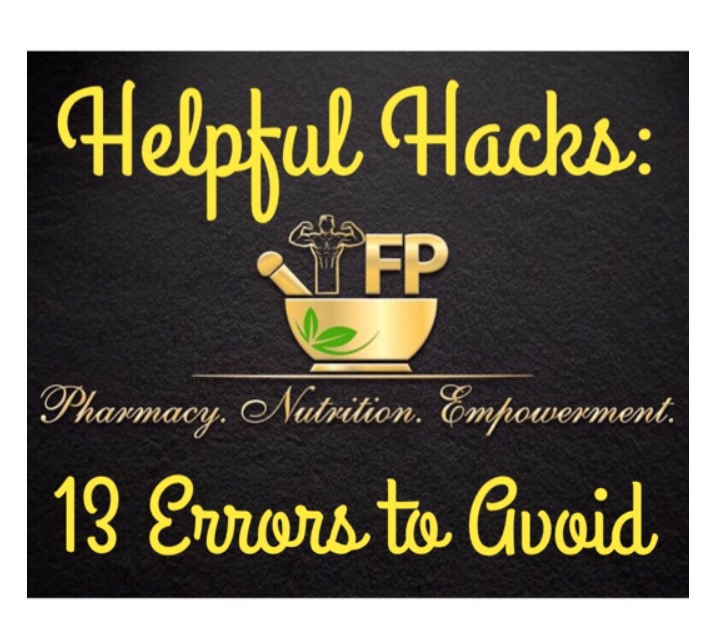HELPFUL HACKS FOR NEW GRADS
Through social media, I have had the privilege of meeting and working with The Fit Pharmacist, Adam. Not only is he an inspiring pharmacist, he’s an avid exercise and nutrition enthusiast who is passionate about keeping our bodies healthy.
Once a week, I like to focus on students and Adam has written a great piece for new grads that I find helpful! When you graduate, you are hit with a ton of new responsibilities and information. You meet hurdles daily and wonder if you need to ask, figure it out, or dig deep into your brain to see if you can access the answer. This article helps address some of those issues:
Helpful Hacks: 13 Errors to Avoid as a New Grad and How YOU Can Avoid Them!
The number one fear of every pharmacist is making a mistake. If you have experience on the job, the likelihood of making one goes down. However, what if you’re a new grad, with no experience of working the bench solo? I am here to help: I have compiled a list of the most common oversights made by newly licensed pharmacists working in the community pharmacy as a means to bring them to your attention, and help you avoid falling privy to these potential pitfalls.
Verification: Wrong patient
Get in the habit of having a checklist you run through when verifying prescriptions, regardless of if it’s a first fill or refill. In particular, ALWAYS look at BOTH the patient name AND date of birth. All too often, searching a patient in the system is done solely by the name, or solely by the date of birth. I can’t tell you how many times I’ve caught this error, with same name/different date of birth, or same date of birth/different name- ALWAYS CHECK BOTH!
Verification: Wrong medication
Whether it’s tablets or capsules, always check ALL the contents of a vial to ensure no loose pills accidentally got mixed in. Have you ever run out of vials in your carousel, and seen a bunch of random pills at the bottom? Sometimes, they land in the bottle rather than the bottom, and can be overlooked by the technician filling the prescription. Double check, because even if you didn’t put it in there, you are the one who will be signing off on it.
Refrigeration requirements
Know thy medicine! If a product requires refrigeration, be sure to know the proper storage requirements, as some have very strict guidelines. The most commonly overlooked products are topical creams and gels, and some are extremely costly if not handled properly. For example, Picato® (ingenol mebutate) is a gel that must be refrigerated at 36°F to 46°F, and according to the manufacturer, must be discarded if left in an environment above 87°F for more than 2 hours. Big counseling point if a patient is driving home in a hot summer, too!
Multiple containers for one medication
90-day supplies are all the rage nowadays, and with that increases the quantity dispensed for prescriptions (drawing straws for who counts #360 metformin may come to mind). That means that often times, multiple vials will be required to fill one prescription order- BE SURE TO CHECK ALL VIALS! Don’t just check one and assume the rest are right- be thorough!
Another common oversight with multiple labels is not dispensing the correct amount. Knowing how your pharmacy numbers certain medications (e.g. is Ventolin HFA® labeled as #18, or #1 for one inhaler) can prevent this issue. Be sure that if a Rx was written for 3 inhalers and it was billed and filled as such, all 3 get dispensed. Birth control is another common oversight in this regard, leading into the next tip!
Birth controls
Many women are very sensitive to hormone therapy, and do not tolerate change well. Always check a patient’s fill history before giving the OK- this medication category is a frequent flier for brand name requirements. Another reason this is helpful is that the Rx can be written for the wrong strength by the prescriber or office staff. A simple phone call to the patient asking them if their dose changed, or a note on the prescription to get the pharmacist is all it takes to prevent undue frustration!
One more thing that can make a difference: days supply. If the directions on the Rx state “skip placebo and start new pack” or something of the sort, ensure your days supply matches up. If it’s for a #28 tablet pack of Sprintec® with those directions and you enter #28 days supply, their next refill may be blocked by the insurance as a refill too soon. Just one more tip that can prevent avoidable issues!
Counseling required
If you don’t have time at the moment to call a patient, but need to speak with them regarding a Rx, keep the Rx at your station so when they come to pick it up you’ll have it, or staple a note over the bar code so that the technician ringing up the patient will be sure to see it. It’s always best to call, but if it’s ensuring an address or phone number change, this will ensure the question will be asked!
Drops in Ears or Eyes
When checking a prescription for drops, ALWAYS ALWAYS triple-check the route of administration! This can be a huge issue if missed, particularly if they are eardrops and the instructions read “for the eye”. QUICK TIP: eye drops are sterile, and can be used for the eye or ear. Ear drops are NOT sterile, and should NEVER be used in the eye!Some drops come both as a solution AND suspension- be sure to pay attention to detail and select the correctly prescribed formulation!
Lovenox® (enoxaparin sodium)
These come in boxes of 10, and depending on the manufacturer your pharmacy carries are not sealed! Some patients are on twice daily dosing long term, meaning #60 or 6 boxes for a 30-day supply. Make sure you open every one to inspect that the correct dose is in the box, as well as the expiration date has not yet past.
Single-Use Medications
Dovetailing from the last tip, single-use medications need to be individually verified that they are the correct dose and formulation. An example of this is Rizatriptan- are they all MLT? The same dose? Always check each packet to be certain!
Stock Bottle Variances
Many times, there is an order for #90 tablets, and the stock bottle for that particular medication is for #90. Also many times, the manufacturer makes several different quantites of stock bottles (#30, #90, blister packs, etc)- on example is lamotrigine: 150mg and 200mg stock bottles contain #60, yet the 25mg and 100mg contain #100. This can also vary by which manufacturer of a particular medication your pharmacy carries. Bottom line: if you label a stock bottle vs. filling an amber vial, be sure to check that the quantity is correct!
Reconstitution Nuances
As we enter the peak of cold and flu season, the number of antibiotics you dispense will go up- and if the Rx is for a youngster, it will likely be for a reconstitute medication. Knowing how long each antibiotic is good for once mixed is KEY- especially because the duration of therapy indicated by the prescriber may be longer than that time. For example, a physician may require a patient to be on a set course of antibiotics for 14 days to appropriately treat the infection, yet the medication is only good for 10 days once reconstituted. Be sure to know your pharmacy’s policy on how to address this, and know which medications last how long.Helpful Hint: It’s often printed right on the bottle, in the same area stating how much water is required for reconstitution.
Lead By Example
In the community setting, pharmacy technicians are your life force- they should be treated as such! You are a team: it’s not a dictatorship. Do you want them to get the drive through? Refill the amber vials? Fill the printers? Sweep the floors? Have YOU ever done those things? Leading by example is the most powerful way to build rapport and earn respect with your team. Throw out the “I have a doctorate, I’m not going to subject myself to…” and you have just lost all respect. That’s not to say you have to do these things all the time- counseling our patients and ensuring safety will always be our number one priority- but if you work with your nose in the clouds, soon you will find that help is nowhere to be found up there.
Trust Your Intuition
I saved the best for last: if you have a feeling that something isn’t right, or there’s something just ‘off’, ACT ON IT! Just because a physician wrote a prescription doesn’t mean it’s right- if you have any feeling whatsoever that there even could be an issue, make a call. Look up the dose. Do what you can to make an honest effort to ensure that the prescription you are checking with your hard-earned license is correct!
Follow-up tip: if you are going to call the prescriber because you don’t think something is correct, have an alternative or suggestion prepared and at the ready to suggest. We work as a team, and more often than not the prescriber is glad that you called and wants to hear your expertise on how you can best help the patient.
This list is by no means all inclusive- you should always use your best judgment! However, hopefully knowing these potential pitfalls will prepare you to prevent them from occurring! Be alert, thorough, and always know your resources for where to turn for an answer. “You don’t have to know everything, but you DO need to know what you don’t know- and where to find what you don’t know.”Special thanks to Souhail, Jatinder, and others who contributed to this list to help prevent undue errors!

